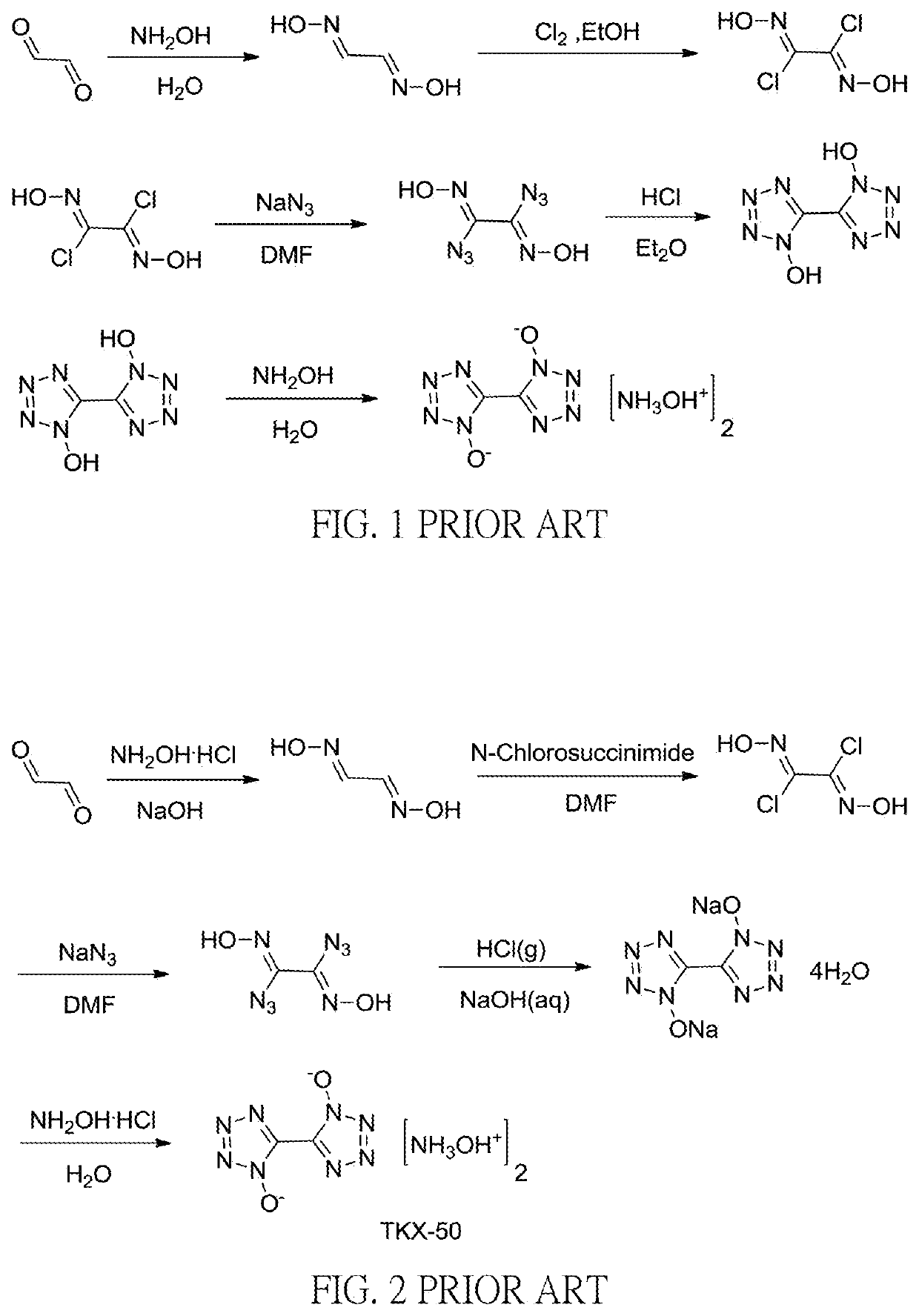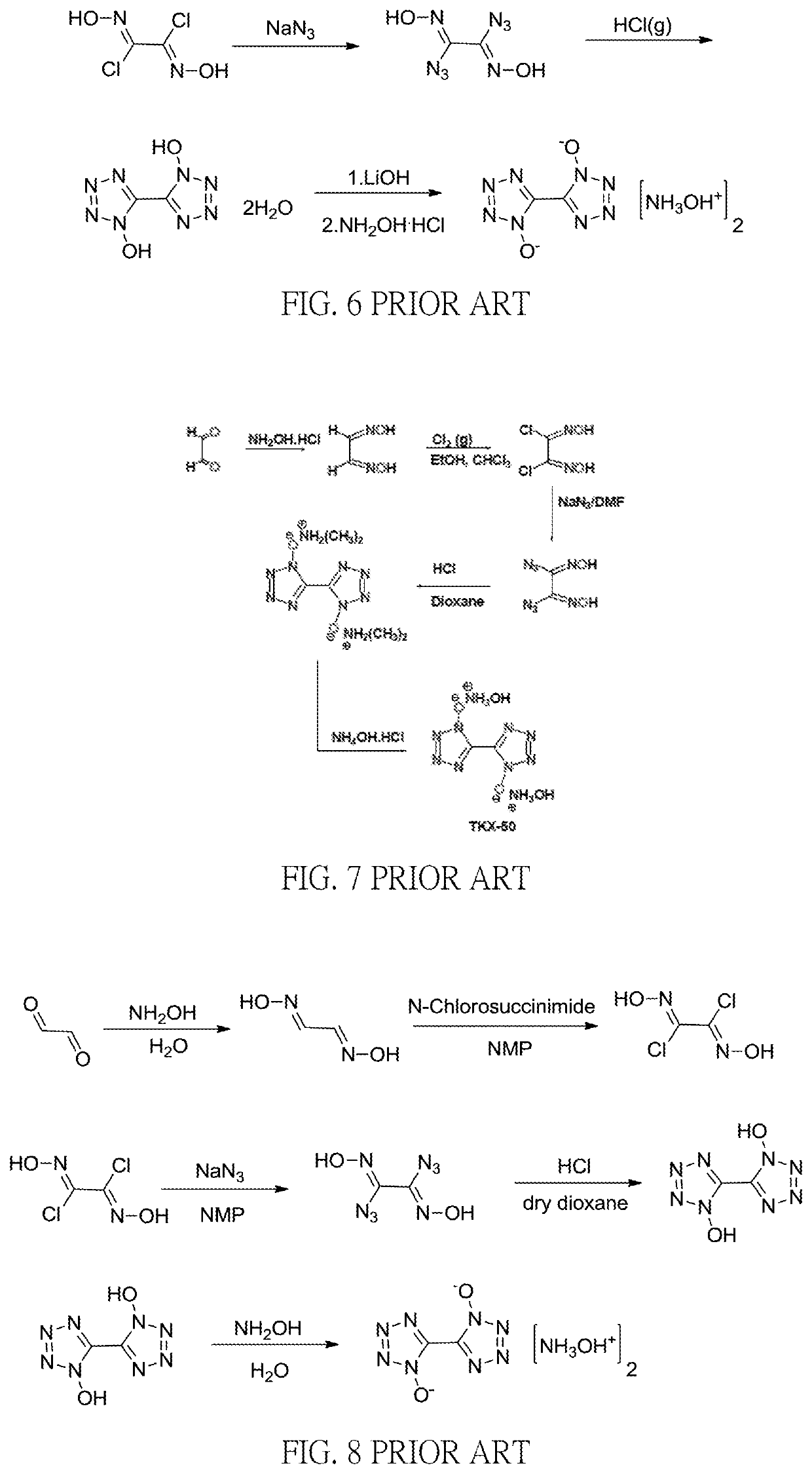Method for preparation of insensitive high explosive
a high explosive, insensitive technology, applied in the direction of explosives, weapons, organic chemistry, etc., can solve the problems of difficult product separation, less safe operation, and easy side reaction of the oxidation step, so as to reduce waste acid, easy operation, and high yield
- Summary
- Abstract
- Description
- Claims
- Application Information
AI Technical Summary
Benefits of technology
Problems solved by technology
Method used
Image
Examples
example 1
[0045]To a 250 mL reactor hydroxylammonium chloride (37 gm) and water (40 gm) were added while stirring at room temperature. Sodium hydroxide (28.6%, 56 gm) was added dropwisely while cooling to 0° C. and glyoxal (40%, 38.6 gm) was added dropwisely to carry out the reaction at 0° C. for 20 minutes then warming up to 25° C. to carry out the reaction for 2 hours. Glyoxime was obtained after filtration with approximately 92% yield.
[0046]Then glyoxime (5 gm) was further dissolved in 50 mL of N,N-dimethylformamide (DMF) and N-chlorosuccinimide (15 gm) was added when cooled to 0° C.˜10° C. The reaction was carried out for 1 hour when warmed up to 25° C.˜35° C. After cooled to −5° C.˜5° C., sodium azide (7.4 gm) was added to carry out the reaction for 3 hours. After concentrated sulfuric acid (36.6 gm) was added dropwisely to carry out the reaction at 60° C.˜70° C. for 14 hours and cooled, a 40% sodium hydroxide aqueous solution was added dropwisely to adjust the pH value to be approximate...
example 2
[0047]Glyoxime (5 gm) was dissolved in 50 mL of N,N-dimethylformamide (DMF) and N-chlorosuccinimide (15 gm) was added when cooled to 0° C.˜10° C. The reaction was carried out for 1 hour when warmed up to 25° C.˜35° C. After cooled to −5° C.˜5° C., sodium azide (7.4 gm) was added to carry out the reaction for 3 hours. After concentrated sulfuric acid (52.3 gm) was added dropwisely at 60° C. 70° C. to carry out the reaction for 15 hours and cooled, a 40% sodium hydroxide aqueous solution was added dropwisely to adjust the pH value to approximate 10 to obtain 1,1′-dihydroxy-5,5′-bistetrazole sodium salt tetrahydrate (BTO-Na-4H2O) after filtration. The 1,1′-dihydroxy-5,5′-bistetrazole sodium salt tetrahydrate (BTO-Na.4H2O) was dissolved in enough water and a hydroxylammonium chloride (42.3%, 23.44 gm) aqueous solution was added dropwisely to carry out the reaction at 60° C.˜66° C. for 2 hours. Dihydroxylammonium 5,5′-bistetrazole-1,1′-diolate (TKX-50) was obtained after cooling and filt...
example 3
[0048]Glyoxime (5 gm) was dissolved in 50 mL of N,N-dimethylacetamide (DMAC) and N-chlorosuccinimide (15 mg) was added when cooled to 0° C.˜10° C. The reaction was carried out for 3 hours when warmed up to 30° C.˜40° C. After cooled to −5° C.˜5° C., sodium azide (7.4 gm) was added to carry out the reaction for 3 hours. After concentrated sulfuric acid (52.3 gm) was added dropwisely to carry out the reaction at 60° C.˜70° C. for 15 hours and cooled, a 40% sodium hydroxide aqueous solution was added dropwisely to adjust the pH value to approximate to obtain 1,1′-dihydroxy-5,5′-bistetrazole sodium salt tetrahydrate (BTO-Na.4H2O) after filtration. The 1,1′-dihydroxy-5,5′-bistetrazole sodium salt tetrahydrate (BTO-Na.4H2O) was dissolved in enough water and a hydroxylammonium chloride (42.3%, 23.44 gm) aqueous solution was added dropwisely at ° C.˜66° C. to carry out the reaction for 2 hours. Dihydroxylammonium 5,5′-bistetrazole-1,1′-diolate (TKX-50) was obtained after cooling and filtrat...
PUM
| Property | Measurement | Unit |
|---|---|---|
| temperature | aaaaa | aaaaa |
| temperature | aaaaa | aaaaa |
| temperature | aaaaa | aaaaa |
Abstract
Description
Claims
Application Information
 Login to View More
Login to View More - R&D
- Intellectual Property
- Life Sciences
- Materials
- Tech Scout
- Unparalleled Data Quality
- Higher Quality Content
- 60% Fewer Hallucinations
Browse by: Latest US Patents, China's latest patents, Technical Efficacy Thesaurus, Application Domain, Technology Topic, Popular Technical Reports.
© 2025 PatSnap. All rights reserved.Legal|Privacy policy|Modern Slavery Act Transparency Statement|Sitemap|About US| Contact US: help@patsnap.com



